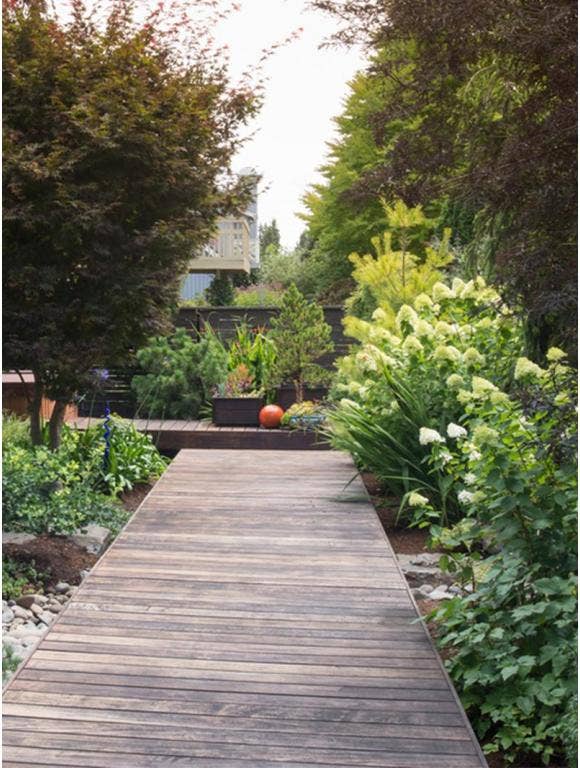


A small, narrow garden presents some challenges, but by embracing the footprint and employing some narrow garden design ideas, you can turn those challenges into opportunities.
Susan Morrison, landscape designer and co-author of "Garden Up! Smart Vertical Gardening for Small and Large Spaces," believes narrow spaces can actually become the most interesting gardens. "People don't realize how much they can do with a narrow space," says Morrison. "So most of our imaginations don't go beyond a hedge or a vine."
A fence or wall often leaves us with a long, slender stretch of ground. The tendency, Morrison says, is to cover the wall and find a way to fill the space, but by tweaking the design strategy and using the proper plants, this undervalued area can become one of the most interesting parts of the garden.
Narrow Garden Design Ideas
By incorporating some narrow garden design ideas, such as establishing different zones and levels, using vertical elements and adding curved pathways, you can reduce the "corridor" appearance and maximize the potential of a small, narrow garden.
Go Vertical and Create Layers
One secret to creating a beautiful and spacious-feeling garden lies in vertical layers.
"The traditional approach is planting front to back. But in a narrow space, you don't have that much room," says Morrison. "So instead, create layers vertically. Layer up, not out. Think in layers of top, middle and bottom instead of front, middle and back."
Vertical elements drive the eye upward to offset the narrow footprint. Add height with tall plants, potted trees and garden structures like trellises or arbors for vining crops or ornamental plants. Put an empty vertical surface to work by planting an herb wall, or create a living sculpture by training fruit trees into espaliers.
"If you add a vertical system like a trellis or a vertical pocket wall, it will increase the variety of plants you can grow and allow you to grow edible plants," says Morrison. "Vertical systems are also a cool design element."
Make sure to also pay attention to the amount of sun your garden gets. As many elongated gardens are shaded by a wall or two, it's important to choose plants well suited to the garden's available sun. Be sure to consider this when working within the layers of the garden as well.
Top Layer
For the top layer, choose a vine that lies flat against a wall or other vertical surface. Consider vase-shaped shrubs that are slender at the bottom and flare out toward the top to showcase their attention-grabbing foliage and blooms.
Middle Layer
An airy middle layer is key to making the narrow garden feel larger.
"Our eyes rely on a variety of cues to perceive depth," said Morrison. "So when we can fit two or three plants into a space that looks like there's only room for one, it tricks the eye into thinking there's more space than there is."
Morrison suggests finely textured medium-height ornamental grasses or tall flowers, such as foxgloves or snapdragons, that provide a light and airy feel. They create the illusion of filling the space and can make small spaces appear bigger.
Bottom Layer
For a slim bottom layer, choose plants that will grow to a maximum height of 1 or 2 feet, such as short ornamental grasses with a good foliage color, like 'Aureola' hakonechloa, or a ground-hugging shrub, such as the 'Tiny Dancer' lilac. Short mounding perennials including creeping phlox fit nicely into cramped spaces and also work well for accentuating pathways.
Disrupt a Linear Footprint With Curved Pathways
Pathways are one of the most functional and important design elements in a small, narrow garden.
While it may seem counterintuitive, a wider, curved path will interrupt straight lines to create the illusion of a wider space.
"Just adding a slight curve to the pathway does wonders to break up the boxy, narrow garden," said Morrison. "Making the path too narrow has the opposite effect: It's going to make the whole space feel cramped." A wide pathway in a narrow garden will also accommodate wheelbarrows or lawnmowers and make it easy to navigate the space.
Create Different Zones
To reduce the "corridor" look, divide a long, narrow garden into smaller distinct zones or rooms. One area might be for dining and another for lounging, each connected by winding pathways. Use trellises or an arbor as screening between them, making sure to allow views through and beyond each zone.
Design in Levels
Create different levels to interrupt the linear flow and break up a long site line. Incorporating grade changes in a small, narrow garden can help establish and define the multiple zones. Install slightly elevated decking for a dining table and chairs, or build low rectangular planters to add height between spaces and separate the garden rooms.
Add Horizontal Elements
Horizontal elements such as a raised bed, low stone wall or plantings placed perpendicular to the narrow stretch of the garden will offset a long, narrow expanse.
Establish a Focal Point
Draw the eye to a focal point at the end of the garden and add an element of surprise with a lush living wall, water feature, sculpture or seating area with a fire pit.
Tie It All Together
Unifying these various landscaping features will go a long way toward transforming your small, narrow garden into a functional and swoon-worthy space.
Ready for more inspiration? Take our garden goals pop quiz to find the perfect seeds and plants for your space.



